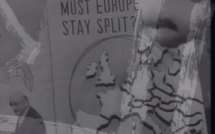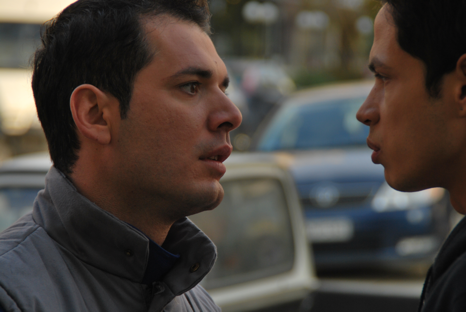

This is part of our special feature on European Culture and the Moving Image.
Prospective audiences may be at a loss if they try to conjure in their minds an Albanian film, especially since production has gained momentum only in the last twenty years. The country itself began rebuilding itself, following the collapse of the Eastern Bloc in 1989, and a catastrophic transition to a liberal democracy that kick-started mass migration amidst immense financial instability. Most popular cinematic references to Albania and Albanians can be discerned in major blockbusters and Hollywood franchises like the notoriously xenophobic Taken trilogy (2008-2014) by director/producer Luc Besson, which features Albanian sex traffickers as prototypical adversaries to Liam Neeson’s ex-CIA agent. As is often the case for countries of the former Eastern Bloc and Balkans, Albania and Albanians are burdened by negative stereotypes. Cinema can be a potent source of more thought-provoking insights, a notion that this article will establish by discussing the possible links between Albanian cinema and European film production with a focus on two case studies: Robert Budina’s 2012 Agon, a social drama about the efforts of Albanian migrants to become integrated in European host societies, and Bujar Alimani’s 2011 Amnistia/Amnesty, an allegorical critique of Albania’s European agenda and patriarchal custom. Both films are exemplary of contemporary Albanian cinema in their preoccupation with social upheavals that Albanians face at home and away.
Albanian films are nearly impossible to source for home viewing as international distribution is limited and hard to attain. In many cases, one might have to rely on a chance broadcast from a television channel and a recording apparatus ready at hand. In fact, I obtained Amnesty by a colleague who copied it from Greek cable TV channel Nova, while I purchased Agon from a Greek distributor. The film is available on DVD solely with Greek subtitles. Albanian films are generally produced and circulated in the margins of European and global film production. It is maybe no wonder, then, that aside from film festival curators, its major interest groups are scholars. However, the proliferation of regional film festivals in Europe has brought renewed currency to marginal cinemas like Albania’s.
Albanian cinema behind the ‘Iron Curtain’ (1944 – 1985)
A serious shortage of awareness surrounding Albania’s culture is chiefly a symptom of the country’s isolation in the post-War period, specifically during the reign of communist leader Enver Hoxha that lasted from 1944 until shortly after his death in 1985. Hoxha severed all ties with the West, but also with communist allies, throwing Albania into a state of isolation unprecedented in the Balkans and former Soviet Union. At the same time, filmmaking bloomed with 247 films produced between 1957 and 1990. Hoxha saw in cinema it’s potential as a propaganda tool and invested very generously in the creation of Albania’s Kinostudio in 1952. Screenings of Albanian films at international festivals were a rare occasion and the films were generally dismissed for their political agenda, with China providing the only regular foreign audience.[1] At the same time, films from Eastern European countries like Poland, Czechoslovakia, and Hungary received international distribution and filmmakers like Andrej Wajda from Poland and Czech director Miloš Forman became household names. Albanian films however were produced solely for internal consumption with no appeal within or outside the “iron curtain.”
The Interim Period (1991 – 2001)
This state of isolation would slowly change after the regime’s violent fall in 1991, which instigated several waves of migration. By the early 2000s, 500,000 Albanians, from a population of four million, had emigrated to neighboring countries, and with them filmmakers and experienced film crew. Kinostudio veterans who had stayed behind were forced into unemployment and, by 2001, 70 percent of Albania’s film crew had left the country. Already in 1991, the once thriving Kinostudio was dissolved into four sectors and with that the entire infrastructure of the Albanian film industry collapsed as the country all too suddenly entered a transition to a market economy with devastating consequences.
During this interim period, Albanian cinema evolved into an entirely new entity that mirrored the opening of borders across Europe, the free flow of capital and cultural commodities, and the new terrain of interconnectedness in an age of inescapable globalization. A gradual resurgence of film production happened thanks to European funding schemes that ushered in an era of transnational coproduction that functioned together with an expanding European festival circuit to disseminate Albanian films to a wider audience. Transnationalism refers to cultural exchanges across national borders (rather than between as “international” implies), and signals a new era in European film production marked by a greater involvement of the European Union thanks to major funding initiatives which gave a boost to filmmaking.
Many European films are thus no longer de facto products of one distinct nation, but more so coproductions, which implies shared ownership. For Albania, where borders were fortified and people sealed off from any contact with the outside world, this is a momentous turn of events and means that Albanian filmmakers can potentially obtain international visibility and currency as Albania lacks the infrastructure to support filmmaking on a national scale. On the importance of coproduction for small cinemas in post-communist nations, Artan Minarolli, the head of the Albanian Film Centre, mentions in a 2011 interview to Variety that “[Albanian] is a cosmopolitan cinema that tries to survive through cultural exchange. In the past Albania was totally isolated; today we try to find reality in cinema and to make up for the time we lost over the past 50 years.”[2] It is therefore important that we talk about marginal cinemas like Albania that are still emerging from the difficult post-1989 transition and shaping a cinema that can speak in their own name. European image-making, in which both mainstream media and cinema are important in shaping cultural references, is enriched by these new voices emerging from parts of Europe, which till recently, were sealed off and are gradually becoming essential links to the cultural and geopolitical cartography of the new Europe.
For a small and transitional country like Albania, access to European funding is more than beneficial. It is, according to Andrew Horton, a form of “life support,” especially as the role of a producer was unknown and filmmaking was never seen as a commercial venture[3]. This marks a turning point in Albania’s isolationist politics as cinema becomes a site of inclusivity. Albanian filmmakers would additionally become from here on preoccupied with a critical reevaluation of the country’s traumatic history, raising a mirror to a corrupt state and shattered nation. One notable example is Kujtim Cashku’s 1996 Kolonel Bunker/Colonel Bunker, which reexamines Hoxha’s deranged plan to build bunkers all across Albania. It was submitted to the Academy Awards in America as Albania’s official entry for the best foreign language film category and received various accolades, including the UNESCO award at the 1998 Venice film festival. These small victories and gestures of openness indicate how Albanian cinema is steadily becoming part of European film culture, leaving behind its past as a cinema of the “other” Europe.
The early 2000s
Fast-forward four years and Fatmir Koci’s Tirana Year Zero, an Albanian-French coproduction featuring an international cast, receives the Golden Alexander at the Thessaloniki Film Festival, signaling a new era of cultural exchanges with Greece—its closest European neighbor. Tirana Year Zero offers a surreal portrayal of the chaotic interim period and is available on DVD with English subtitles. While the film’s creative background and reception indicates several transnational/European links, the film, per se, is more inward looking. It provides an unapologetic observation on a country and people at a historical juncture, expressing a plea to the disenfranchised Albanian youth to stay home and rebuild the country.
In the same year, Gjergj Xhuvani released Slogans, a fierce indictment of the Hoxha regime’s propaganda. Slogans was the first Albanian film to be shown at the Cannes film festival, winning several awards at smaller festivals. Despite genuine successes in rectifying decades of isolation, the film industry was still on desperate “life support” mainly through the Fonds Suds fund (known as Aide aux cinemas du monde since 2012) of the French National Cinema Centre that provides selective aid to the cinema of underdeveloped nations.
In terms of content, Albanian filmmakers in the 2000s tend to depict the lives of Albanian migrants in exile and at home. This doesn’t happen in a vacuum as migration is one of the most burning issues in contemporary Europe and migrant stories feature regularly in European cinema since 1989. Respective films prioritize the perspective of migrants, “speak” in several languages, and are awarded at European film festivals. They showcase a growing preference for films that rectify the misrepresentation by mainstream media outlets, illustrating in the process the diversity of the European continent. Contemporary Albanian coproductions conjure the split identities of the growing Albanian diaspora in European metropolitan cities and show how Albanians renegotiate belonging in the changing Europe, offering thus an insider’s look on the experience of Albanian migration. Others illustrate the many challenges of Albania’s interim period, which sees a clash between deeply rooted patriarchal custom and efforts to implement European reform, invoking the Albanian nation’s transitional state. Bujar Alimani’s Amnesty[4] is a fine example of the latter as it envisions the efforts of Albanians to adapt to a new world order.
Bujar Alimani’s Amnesty
Amnesty is a Greek/Albanian/French coproduction, filmed in Albania with the help of a Greek director of photography and crew. Not only is it an ideal example of a European coproduction, but a strong case study on the collaboration between Greece and Albania. The film toured numerous film festivals across the world and was Albania’s official entry for the Academy Awards in 2012.
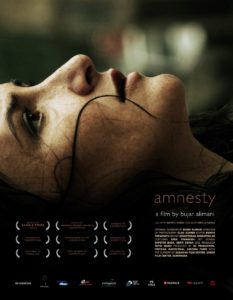
Alimani migrated in 1992 to Greece. In 1997, he became acquainted with Greek filmmaker Yorgos Korras who gave him the opportunity to become assistant camera operator on the set of Mirupafshim/See You (1998), which recounts the friendship of a Greek leftist with a group of undocumented Albanian migrants. In the following years, Alimani rose through the ranks of the Greek film scene, making short films on commission for public broadcaster ERT. These are stored in the archives of both ERT and the Albanian Film Centre.[5] Amnesty marks a watershed in the relations between Greece and Albania as it is the first film to receive funding by the Greek and Albanian Film Centres, making it an obvious joint effort between two Balkan neighbors and, simultaneously, Europe and its peripheral “Others.”[6] Moreover, its executive producer is Alimani’s regular partner and friend Thanos Anastopoulos, director of Diorthosi/Correction (2008), which features both Bujar and his daughter Savina Alimani in small roles, revealing further how cultural production brings Greeks and Albanians closer. European film production seems to be forming into a new terrain of rhizomatic[7]links rather than a group of distinct national cinemas with clearly defined borders.
Amnesty travelled to the prestigious Berlinale where it received the award of the International Confederation of Art Cinemas (CICAE). The CICAE was created to “bring together federations or associations of art-house cinema theatres under an international association, with a view to fostering cooperation among members” and “to ensure that national and international authorities recognize and support the art-house film industry, via its representative bodies[8].” With this award, Alimani’s film is framed in terms of European art-house filmmaking and its various institutions (festivals, funding bodies, venues).
The film’s starting point is actual legislation concerning conjugal visitations in prisons as part of European demands to grant greater freedom to inmates, which Albania must comply with in order to ultimately join the EU. Incidentally, the film opens in a prison where the main characters, Elsa (Luli Bitri) and Shpetim (Karafil Senja), fulfill their obligation to meet their spouses in prison, a decision which they reluctantly conform to. This may seem like a move in the right direction but, as the story further unfolds, it becomes clear that the real prisoners in the film are Elsa and Shpetim who eventually fall in love, breaking thus with traditional rules of conduct which reproduce the mantra “family, honor, nation.”
Elsa is exemplary of a generation of Albanian wives and mothers heavily burdened by patriarchal expectations. During her visits, her husband, a bulky and menacing figure, forces himself on her, while, at home, her father-in-law monitors Elsa’s every move. Conversely, Shpetim does not fulfill the tenets of Albanian masculinity. He is an antihero who spends his days at home drinking and watching porn films, his wife dominating over his passive body during his first conjugal visit. As allegorical figures in a visibly changing nation, they embody a generation of men and women who feel trapped in their roles as husband and wife. Eventually, Elsa and Shpetim rebel by becoming a couple, but adultery does not go unpunished. Once out of prison, husband and father-in-law execute the lovers in cold blood, rendering the potential of democratic reform open questions. Amnesty aptly underscores Albania’s painful transition to a liberal democracy and visualizes the tensions between European reform and patriarchal law that is incompatible with western liberal norms and an impediment to Albania’s European agenda.
With Amnesty, Alimani articulates his personal thoughts on the state of his homeland, looking at a nation in transition as an outsider and insider, a migrant both away from and at home. He is an exemplary case of a new European filmmaker of migrant and diasporic background who has transcended these categories and developed dual belonging in Europe. The question of belonging and the integration of diasporic subjects are at the heart of Agon[9].
Robert Budina’s Agon
Robert Budina moved to Italy in 1996. Contrary to Alimani, his filmmaking career took off only upon returning to Albania in the early 2000s. Like many diasporic filmmakers, he instills in Agon (which translates as “dawn”) his own experience of exile and the emotional landscapes of exilic life. Agon is a Greek/Albanian/Romanian/French coproduction, made with the support of Eurimages, the cultural support fund of the Council of Europe[10]. Agon is even more exemplary of the transnational turn in European cinema than Amnesty as it involves narrative border-crossing from Albania to Greece and back. Indeed, the film’s protagonists cross over several times in sequences where we see the geographical borders that divide Europe and Albania. Agon’s contributors include also Balkan, European and Eastern European sources reflecting further the multicultural make-up of contemporary European and diasporic cinema.

Agon tells the story of Saimir (Marvin Tafaj), a first-generation Albanian migrant living in Thessaloniki, Northern Greece. Saimir has learned Greek and is set to marry his Greek fiancée Electra. He works at her father’s garage and plans to buy an apartment and start a family. His stable life becomes deeply unsettled when his rebellious younger brother, Vini (Guliem Kotori), moves in. Unable to integrate and hold on to a job, Vini is lured into the underground Albanian mafia. Saimir struggles to protect his brother and simultaneously maintain a sense of peace with his host family as his father-in-law Nikos and his business are threatened by Albanian mobster Keno and his thugs. In addition to this, he is pressured to show greater loyalty to his Albanian roots, bringing to mind the pressures that young Albanian men face by patriarchal norms. The film ends with Vini getting shot and Saimir, Electra and Nikos, heading to Albania to bury him.
On the surface, Agon is a family melodrama. On a deeper level, Budina’s film pays homage to those who manage to settle all the while acknowledging the inevitable sacrifices they make in tackling the pressures of home and host society. Saimir strives for balance between the Greek and Albanian family, respectively his future and past. Achieving this balance is far from simple because, in order to marry Electra, Saimir must convert to Orthodox Christianity and change his name. This difficult balancing act is perfectly illustrated when Saimir’s extended and adoptive families meet in a sequence that emblematizes his dual loyalty. The unexpected visit of aunt, uncle, cousins and their kids comes with the kind of humor that culture clash often provokes and the ethnic stereotypes associated with Balkan families. The nearly comical image of the Albanian family, seeming out of place, standing between a confused Electra and a nervous Saimir is telling of the awkward coexistence of different cultures under the same (European) roof. Saimir is also antagonized by Vini who insists that his brother is marrying merely to receive permanent residence and that he changed his name—a sign of betrayal. Contrary to Vini, Saimir maintains a more open approach to the triptych “family, honor, nation” and tries to accommodate two nations as though to embody the spirit of transnationalism.
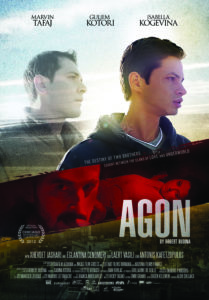
Agon’s finale brings Budina’s vision of reconciliation full circle. Saimir, Nikos and Electra travel to Albania to return Vini’s corpse to its rightful place. This gesture, as though to heal the Albanian nation, signals the potential of ultimately bridging two different worlds. What’s more, Electra is pregnant and her father, who joins the couple to Albania, has visibly changed. The shot of him standing at a crossroad and asking for directions indicates his being out of place and openness to the world of the “Other.” Everyone is ultimately at peace, but Saimir has had to suffer obvious losses. Such is the strife that migrants undergo on the way to finding home away from home.
Conclusion
Amnesty and Agon are implicitly about the past, present, and future of Albania and Albanian cinema. They bring into relief the country’s lasting and painful transition and the many obstacles the Albanian people face as a result, both at home and away. They showcase two major symptoms of the post-communist era—namely mass migration and the yoke of deeply rooted patriarchal custom. These films demonstrate how younger generations of Albanians diverge from the canons of tradition, which has obvious gender implications, as seen especially in Amnesty. Agon also features a clash between conservative and modern values, but this time in relation to the efforts of migrants to reconcile conflicting tendencies between home and host nation. Indeed, these films are exemplary of the struggle that lies ahead for Albanians that involves bridging values and rules of conduct of conservative Albania and modern-day Albania open to Europe and European reform, as though to project a future version of Albania without the burdens of its traumatic past.
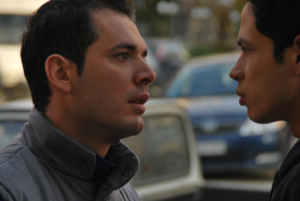
With their transnational creative background, Albanian films serve as reminders of the importance of coproduction for the cinemas of transitional and poorer nations. In terms of their cultural identity, they oppose the old order of a strictly national cinema and indicate the openness of coproduction, alongside its practical value. Collaborations across national borders involve the present and, most importantly, the future of Albanian cinema.
Philip E. Phillis holds a PhD in Film Studies from the University of Glasgow. He is the author of Greek Cinema and Migration (1991-2016) and has published extensively on European cinema and migrant representation, Greek film culture and transnationalism. He has taught Film and Media Studies at The University of Glasgow and Glasgow Caledonian University and currently teaches Film and Media Studies at Sciences Po Collège in the city of Le Havre, France.
References
[1] Williams, Bruce, “Red Shift: New Albanian Cinema and its Dialogue with the Old”, in Imre, Aniko (ed.) (2012), A Companion to Eastern European Cinemas (Sussex, Wiley-Blackwell).
[2] Holdsworth, Nick, “Albanian Oscar Entry Disqualified”, in Variety, October 9 2011. Found online at https://variety.com/2011/film/awards/albanian-oscar-entry-disqualified-1118044156/
[3] Horton, Andrew, “Will the last person to leave the country please turn out the lights, Fatmir Koçi’s Tirana Year Zero (2001)”, in Kinoeye,November 21 2001. Found online at https://www.kinoeye.org/01/07/horton07.php
[4] A trailer of Amnesty is available to see here https://www.youtube.com/watch?v=uU1D67lAjYI&ab_channel=MappealTv
[5] Phillis, E. Philip, (2020), Greek Cinema and Migration (1991-2016), (Edinburgh, Edinburgh University Press), p.41.
[6]_____________, Review of “Amnesty” in Filmicon, Journal of Greek Film Studies, Issue 1 (2013). Found online at https://filmiconjournal.com/journal/article/page/12/2013/1/11
[7] The term, coined by French philosopher Gilles Deleuze, invokes the rhizome, that is a mass of roots, as a meaningful form of non-hierarchical knowledge and representation. Contrary to a linear way of thinking and interpreting the world, the rhizome acknowledges the possibility of many tangential links.
[8] For more on the role of the CICAE see the confederation’s website at https://web.archive.org/web/20120325105559/http:/www.cicae.org/en/status
[9] A trailer of Agon is available to see here https://www.youtube.com/watch?v=hEG4KH0xdCM&ab_channel=ErafilmProduction
[10] The Eurimages Foundation has been active since 1989. It numbers 39 of the 47 member states of the Strasbourg-based Organisation, plus Canada as Associate member. For more on the role of the Eurimages Foundation, see their website at https://www.coe.int/en/web/eurimages


